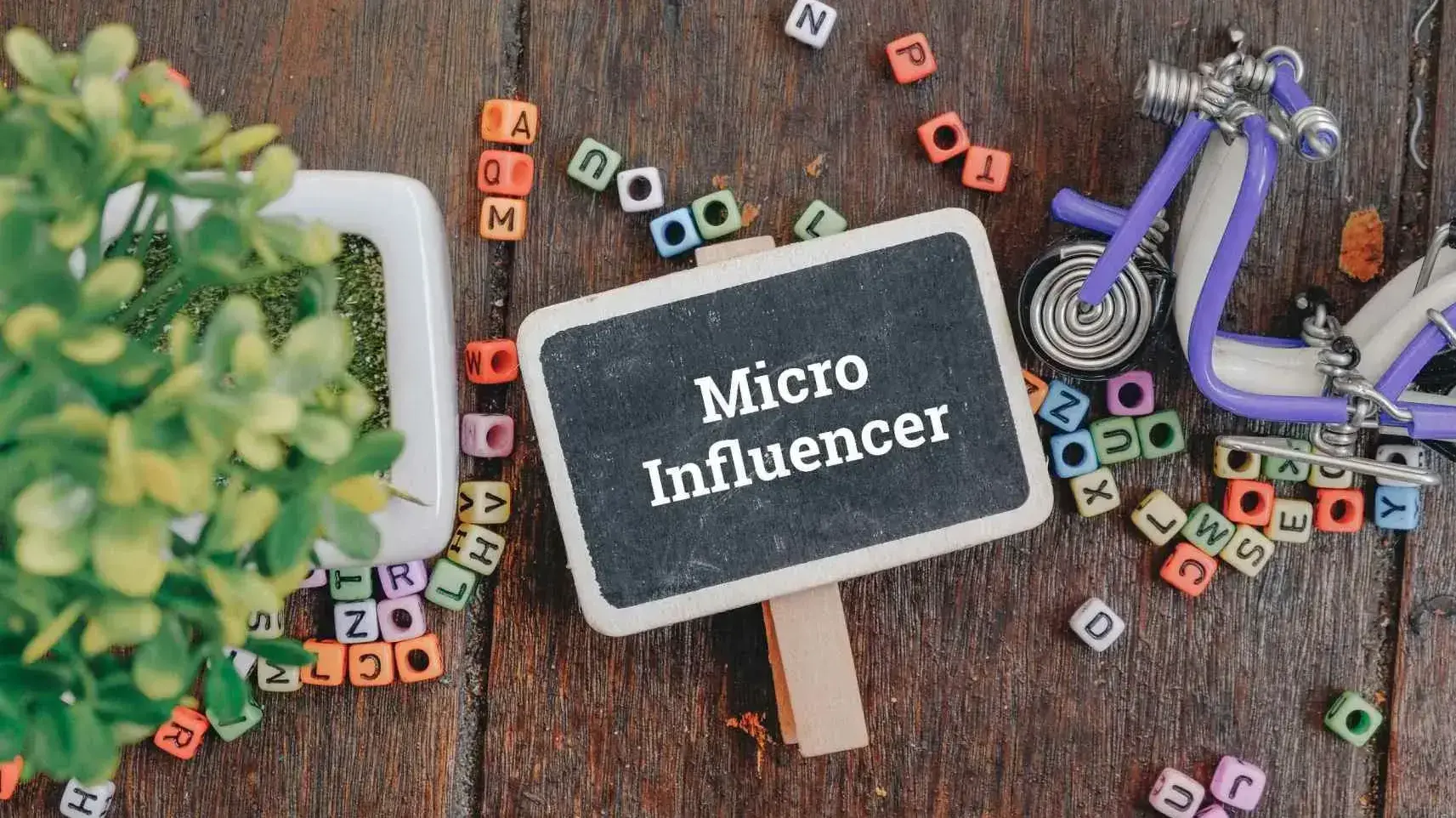Using influencer marketing to promote a product or service has a long and interesting history beyond just social media. People often trust celebrities so much or aspire to be just like them that we'll be the shoes, beverages, clothes, or electronics that our favorite celebrity endorses.
Some part of our brain says, "If I own that, then I'll be just like them." So we buy whatever they're selling.
Hiring celebrity influencers is an effective marketing tool and one you could probably take advantage of. But, hiring mega influencers and celebrities can be expensive.
For one thing, many of them demand thousands of dollars for a single social media post. A celebrity will get many thousands of dollars for a single TV commercial and a few million for a whole campaign. A mega influencer can get tens of thousands of dollars for a single month.
So, how do you get mega-influencer results when you just don't have a mega-influencer budget?
Work with micro-influencers who can perform the same functions but to smaller audiences. The results may be smaller, but it's less expensive, takes less time, and can go on for longer. In the end, it may even have a bigger impact.
Influencer marketing is growing as more companies embrace the idea of hiring social media practitioners to promote their companies. It started in 2006 with the company PayPerPost, a marketplace that paid bloggers to mention certain products and brands in their posts.
The practice was controversial at first, but online marketing has become a necessary part of doing business for many companies.
According to a January 2023 Yahoo Finance story, "Data Bridge Market Research analyses that the influencer marketing platform market was valued at USD 7.36 billion in 2021 and is expected to reach the value of USD 69.92 billion by 2029."
This article will show you how to find the right micro-influencers, the benefits of working with them, the potential downsides, and how to build a successful micro-blogger campaign.
What are Micro-Influencers
Micro-influencers are social media users who have a small audience for the activity they pursue. They're easier to work with, there are more of them, they're more budget-friendly, and it will cost you a lot less to reach more people with greater engagement.
Micro-influencers pursue a particular niche over a broad category like video games, camping, or cooking They drill down to 1980s video games, winter camping or van camping, cooking rustic Italian food, using hand tools for house building, or dealing with problem dogs.
The topics are narrower, and the audiences are smaller, but there are fewer people doing it, which means they can have a greater impact. Micro-influencers only have thousands or tens of thousands of followers, unlike the macro-influencers, who have hundreds of thousands.
In fact, Sprout Social defines all social media influencers based on their number of followers:
- Nano-influencers: 1K – 10K
- Micro-influencers: 10K – 100K
- Macro-influencers: 100K – 1M
- Mega or celebrity influencers: 1M+ followers
So, micro-influencers and nano-influencers have a small but dedicated audience. They create regular content, and it may not be polished, but people are watching it. And their followers are often more devoted because they feel a closer connection to their favorite influencers.
You can use all of this to your advantage and get a greater reach, all for less money.
Why Micro-Influencers?

Micro-influencers are important to marketing for a number of reasons.
You want to build your brand but don't have the reach or the time to build it. Maybe you want your own brand to be an influencer, but that takes time and a lot of daily content. But you're too busy doing the actual work to do the necessary work every day.
You gain authenticity. A smaller following often means higher audience trust levels. That's because the influencer does their thing because they love it. For example, a local food blogger reviewing a restaurant has more trust than a nationally known figure who's not from there.
You can reach your niche audience of highly targeted demographics and interests. Rather than paying for YouTube ads or sending direct mail, you can reach people who are only interested in the things you sell.
Micro-influencers can't be ad-blocked. There's a proliferation of ad blockers because everyone is sick of online ads. Even though social media marketing is marketing, it's not as intrusive or unwanted as advertising, which is just constant and continual.
People trust their favorite influencers. They're not only real people, they're industry thought leaders. Viewers may not trust advertising, but they trust their favorite social media personalities.
It's cheaper. If you had $10,000 for a marketing campaign, you could buy a single Instagram post from a minor celebrity or two weeks of posts from a mega influencer. Or you could get three months of social campaigns from ten micro-influencers. It
has a wider reach. We already know that it normally takes 6 – 7 touches for a marketing message to take hold, so a three-month campaign will produce better results than that single Instagram post.
It's more cost-effective. A micro-influencer may accept free products instead of cash for their social media campaign. A #vanlife YouTuber might do a 15-minute video about a battery backup system in exchange for one of their batteries, not $2,000.
Finding the Right Micro-Influencers
First, find the social media platforms your customers are using. That means understanding your customers. Ask them which social platforms they use. Look at your Google Analytics. And look for the influencers in your industry. Where do they spend most of their time?
For example, if you sell fitness products, you'll want to be on Instagram, TikTok, and YouTube, where fitness micro-influencers live. If you sell IT products, CTOs aren't scrolling through TikTok; they're on LinkedIn and Alignable.
Next, do some hashtag research. Which hashtags does your industry use? Which ones do your influencers use? Are there any related hashtags in the same posts? Which ones get the most engagement and reach? Are they related to an event, location, product, or philosophy?
Beware of the people who drop dozens of hashtags into their posts. Personally, I only use three or four hashtags in a single post, but some people drop 20+ hashtags at once, which feels a little desperate. Check each hashtag to see if they're actually popular.
Finally, check out the influencer marketplaces. There are several marketplaces where you can post a call for influencers and then choose from the people who responded. These platforms work like Upwork and Fiverr for freelance writers, except they're for people who want to be influencers.
Cipio.ai can help you find micro-influencers for your brand based on their engagement, reach, and total followers. You can avoid people who cheated to get tens of thousands of followers but don't actually have any engagement.
(Disclosure: My co-author on No Bullshit Social Media, Jason Falls, is the VP of Marketing at Cipio.ai)
Potential Downsides and Cautions
Of course, you should know the downsides of working with micro-influencers. There are some risks and issues to be aware of.
For one thing, micro-influencers have a limited reach. Remember, micro-influencers have between 10,000 and 100,000 followers, while macro-influencers have 100,000 to 1 million. It will take ten top micro-influencers to have the same reach as a top macro-influencer.
That means you have to ask yourself whether a single month of a macro's campaign is better than ten micros' campaigns. Generally, things will work in the micros' favor, but there are times when a short macro campaign can work better. You just have to figure out which before you start.
Better yet, combine macro and micro campaigns and measure the results. See who the best results for the lowest cost. You'll discover quickly which ones are the most effective in delivering the ROI you need.
Another problem is that you can get inconsistent quality. Some micro-influencers are just starting out, and they're still learning their craft. They're not quite as consistent in quality or reach, which means you may get a few bad results. They may still be worth it, just don't overpay for them.
You risk overexposure. Think how often you see the same ad in multiple places. You get sick of it and swear you'll never buy anything from that company. This can happen if you saturate the market with a campaign. Start slowly with a few influencers and then build up as you see your results.
Finally, beware of the micro-influencer backlash. Right now, there are so many people who want to be influencers that they make a nuisance of themselves. They make a big deal about getting the "right" picture, setting up tripods and lighting stands, and so they get in people's way.
Many micros ask restaurants, hotels, and destinations for free stuff. They'll ask for a free meal in exchange for Instagram shots. Or a wedding photographer in exchange for telling all their friends. As a result, many places now ban social media influencers, including a town in Vermont, USA.
Influencers of all sizes are getting bad reputations because they come across as entitled. They have built a small social media following and think posting photos and videos will cause people to flock to those brands.
The problem is these baby influencers know nothing about marketing and can't show how they do any good. This has made the restaurants, hotels, and tourist destinations throw up their hands and say, "No more!"
To avoid getting those nuisance influencers, ask your prospective ones for their engagement metrics. Ask them for a marketing plan and how they go about their work. If they tell you about the number of followers and nothing else, avoid them.
But if someone can show you that they have X% engagement and an ROI of X%, and their clients see an X% increase in sales, those are the people you want to work with. They actually know how to market and will do the job right. (This is where a product like Cipio.ai can help you.)
Building Successful Micro-Influencer Campaigns

When you finally start working with micro-influencers and want to build a successful campaign, follow these steps.
Establish clear objectives. Define your campaign goals upfront and write down what it is you want to accomplish. For example, you want to increase website traffic, generate leads, boost brand awareness, or increase sales. (Ultimately, increased sales should be your primary goal.)
Set your collaboration guidelines. Create formal agreements and expectations. Establish the number of social posts your influencers need to make, how many/how long, and the size of engagement you expect. Be sure to establish the pay, schedule, and rights usage.
Determine who owns the content, you or the influencer. Typically, in a creative collaboration like video production or web design, when you hire a freelancer, you own the content the freelancer created. This may be different when working with an influencer.
Set up your monitoring and analytics. You should already be tracking your website's analytics, but ask your influencers to share their results as well. Have them create reports of their engagement rates and then match them up to your sales results.
Use UTM codes to track a campaign, source, medium, content, and term. This can tell you that a particular website visit came from a micro-influencer when someone clicked a link, and X% of the people who clicked that link placed an order.
Final Thoughts
There are several advantages to working with micro-influencers, including reaching more people for less money, having longer campaigns that are cheaper and more cost-effective, and building on their trust and authenticity to promote your own brand.
To build a micro-influencer campaign, you must carefully strategize and make plans before entering any relationships. Then, build strong partnerships with your micro-influencers to maximize the benefits of this new marketing approach.
Frequently Asked Questions
What role does User-Generated Content play in influencer marketing?
UGC is integral to influencer marketing. Influencers often create content that inspires their followers to generate their own, forming a cycle of user-generated content that amplifies the reach and impact of influencer campaigns.
How Can Small Businesses Benefit from E-Business?
Small businesses can benefit from E-Business through global reach, cost efficiency, and improved customer engagement. Digital platforms provide access to a broader customer base, reduce operational costs, and enable direct communication with customers.
Can I upgrade my business over time?
According to the demands that your business has, you can elevate your reseller hosting account at any moment.

Erik Deckers has been a professional blogger since 2009. He is the co-author of Branding Yourself, No Bullshit Social Media, and The Owned Media Doctrine. He published his first humor novel, Mackinac Island Nation, in 2019. Erik has been blogging since 1997, and a newspaper humor columnist since 1994. He has written several radio and stage plays, and numerous business articles. Erik was the Spring 2016 writer-in-residence at the Jack Kerouac House in Orlando, FL, and now serves on their board of directors.
View all posts by Erik Deckers




















